Treatment of Molar-Incisor Hypomineralization and Its Impact on Child and Adolescent Oral Health: A Comprehensive Bibliometric Analysis
Abstract
1. Introduction
2. Materials and Methods
2.1. Data Collection
2.1.1. Search Strategy
2.1.2. Inclusion Criteria for Document Analysis
2.1.3. Exclusion Criteria
2.1.4. Data Sorting and Analysis
2.2. Data Analysis
3. Results
3.1. Growth Trend in Publications and Citations
3.2. Highly Cited Articles on the Treatment of MIH and Frequently Occurring Terms in the Evidence Map
3.3. Worldwide Publishing Trends
4. Discussion
5. Conclusions
Author Contributions
Funding
Conflicts of Interest
References
- Schwendicke, F.; Elhennawy, K.; Reda, S.; Bekes, K.; Manton, D.J.; Krois, J. Global Burden of Molar Incisor Hypomineralization. J. Dent. 2018, 68, 10–18. [Google Scholar] [CrossRef]
- Zhao, D.; Dong, B.; Yu, D.; Ren, Q.; Sun, Y. The Prevalence of Molar Incisor Hypomineralization: Evidence from 70 Studies. Int. J. Paediatr. Dent. 2018, 28, 170–179. [Google Scholar] [CrossRef]
- Lopes, L.B.; Machado, V.; Mascarenhas, P.; Mendes, J.J.; Botelho, J. The Prevalence of Molar-Incisor Hypomineralization: A Systematic Review and Meta-Analysis. Sci. Rep. 2021, 11, 22405. [Google Scholar] [CrossRef]
- Jälevik, B.; Norén, J.G. Enamel Hypomineralization of Permanent First Molars: A Morphological Study and Survey of Possible Aetiological Factors. Int. J. Paediatr. Dent. 2000, 10, 278–289. [Google Scholar] [CrossRef]
- Weerheijm, K.L.; Jälevik, B.; Alaluusua, S. Molar–Incisor Hypomineralisation. Caries Res. 2001, 35, 390–391. [Google Scholar] [CrossRef]
- Diago, A.M.D.; Cadenaro, M.; Ricchiuto, R.; Banchelli, F.; Spinas, E.; Checchi, V.; Giannetti, L. Hypersensitivity in Molar Incisor Hypomineralization: Superficial Infiltration Treatment. Appl. Sci. 2021, 11, 1823. [Google Scholar] [CrossRef]
- Americano, G.C.A.; Jacobsen, P.E.; Soviero, V.M.; Haubek, D. A Systematic Review on the Association between Molar Incisor Hypomineralization and Dental Caries. Int. J. Paediatr. Dent. 2017, 27, 11–21. [Google Scholar] [CrossRef]
- Mazur, M.; Corridore, D.; Ndokaj, A.; Ardan, R.; Vozza, I.; Babajko, S.; Jedeon, K. MIH and Dental Caries in Children: A Systematic Review and Meta-Analysis. Healthcare 2023, 11, 1795. [Google Scholar] [CrossRef] [PubMed]
- Garcovich, D.; Marques Martinez, L.; Adobes Martin, M. Citation Classics in Paediatric Dentistry: A Bibliometric Study on the 100 Most-Cited Articles. Eur. Arch. Paediatr. Dent. 2020, 21, 249–261. [Google Scholar] [CrossRef] [PubMed]
- da Costa Rosa, T.; Pintor, A.V.B.; Magno, M.B.; Marañón-Vásquez, G.A.; Maia, L.C.; Neves, A.A. Worldwide Trends on Molar Incisor and Deciduous Molar Hypomineralisation Research: A Bibliometric Analysis over a 19-Year Period. Eur. Arch. Paediatr. Dent. 2022, 23, 133–146. [Google Scholar] [CrossRef] [PubMed]
- Reissenberger, T.; Ebel, M.; Klode, C.; Hirsch, C.; Bekes, K. Hypomineralized Teeth and Their Impact on Oral-Health-Related Quality of Life in Primary School Children. Int. J. Environ. Res. Public Health 2022, 19, 10409. [Google Scholar] [CrossRef] [PubMed]
- Lagarde, M.; Vennat, E.; Attal, J.; Dursun, E. Strategies to Optimize Bonding of Adhesive Materials to Molar-incisor Hypomineralization-affected Enamel: A Systematic Review. Int. J. Paediatr. Dent. 2020, 30, 405–420. [Google Scholar] [CrossRef]
- Sluka, B.; Held, U.; Wegehaupt, F.; Neuhaus, K.W.; Attin, T.; Sahrmann, P. Is There a Rise of Prevalence for Molar Incisor Hypomineralization? A Meta-Analysis of Published Data. BMC Oral Health 2024, 24, 127. [Google Scholar] [CrossRef]
- Lygidakis, N.A.; Garot, E.; Somani, C.; Taylor, G.D.; Rouas, P.; Wong, F.S.L. Best Clinical Practice Guidance for Clinicians Dealing with Children Presenting with Molar-Incisor-Hypomineralisation (MIH): An Updated European Academy of Paediatric Dentistry Policy Document. Eur. Arch. Paediatr. Dent. 2022, 23, 3–21. [Google Scholar] [CrossRef]
- Donthu, N.; Kumar, S.; Mukherjee, D.; Pandey, N.; Lim, W.M. How to Conduct a Bibliometric Analysis: An Overview and Guidelines. J. Bus. Res. 2021, 133, 285–296. [Google Scholar] [CrossRef]
- Altner, S.; Ebel, M.; Ritschl, V.; Stamm, T.; Hirsch, C.; Bekes, K. Treatment of Severe Caries and Molar Incisor Hypomineralization and Its Influence on Oral Health-Related Quality of Life in Children: A Comparative Study. Int. J. Environ. Res. Public Health 2022, 19, 2983. [Google Scholar] [CrossRef]
- Rodriguez Salazar, D.Y.; Málaga Rivera, J.A.; Laynes Effio, J.E.; Valencia-Arias, A. A Systematic Review of Trends in Photobiomodulation in Dentistry between 2018 and 2022: Advances and Investigative Agenda. F1000Research 2023, 12, 1415. [Google Scholar] [CrossRef]
- Elhennawy, K.; Schwendicke, F. Managing Molar-Incisor Hypomineralization: A Systematic Review. J. Dent. 2016, 55, 16–24. [Google Scholar] [CrossRef]
- Almuallem, Z.; Busuttil-Naudi, A. Molar Incisor Hypomineralisation (MIH)—An Overview. Br. Dent. J. 2018, 225, 601–609. [Google Scholar] [CrossRef] [PubMed]
- Seifo, N.; Robertson, M.; MacLean, J.; Blain, K.; Grosse, S.; Milne, R.; Seeballuck, C.; Innes, N. The Use of Silver Diamine Fluoride (SDF) in Dental Practice. Br. Dent. J. 2020, 228, 75–81. [Google Scholar] [CrossRef] [PubMed]
- Fragelli, C.M.B.; Souza, J.F.; Jeremias, F.; Cordeiro, R.d.C.L.; Santos-Pinto, L. Molar Incisor Hypomineralization (MIH): Conservative Treatment Management to Restore Affected Teeth. Braz. Oral Res. 2015, 29, 1–7. [Google Scholar] [CrossRef]
- Somani, C.; Taylor, G.D.; Garot, E.; Rouas, P.; Lygidakis, N.A.; Wong, F.S.L. An Update of Treatment Modalities in Children and Adolescents with Teeth Affected by Molar Incisor Hypomineralisation (MIH): A Systematic Review. Eur. Arch. Paediatr. Dent. 2022, 23, 39–64. [Google Scholar] [CrossRef]
- Butera, A.; Pascadopoli, M.; Pellegrini, M.; Trapani, B.; Gallo, S.; Radu, M.; Scribante, A. Biomimetic Hydroxyapatite Paste for Molar–Incisor Hypomineralization: A Randomized Clinical Trial. Oral Dis. 2023, 29, 2789–2798. [Google Scholar] [CrossRef]
- Bekes, K.; Heinzelmann, K.; Lettner, S.; Schaller, H.G. Efficacy of Desensitizing Products Containing 8% Arginine and Calcium Carbonate for Hypersensitivity Relief in MIH-Affected Molars: An 8-Week Clinical Study. Clin. Oral Investig. 2017, 21, 2311–2317. [Google Scholar] [CrossRef]
- Coelho, A.S.E.d.C.; Mata, P.C.M.; Lino, C.A.; Macho, V.M.P.; Areias, C.M.F.G.P.; Norton, A.P.M.A.P.; Augusto, A.P.C.M. Dental Hypomineralization Treatment: A Systematic Review. J. Esthet. Restor. Dent. 2019, 31, 26–39. [Google Scholar] [CrossRef]
- Grossi, J.d.A.; Cabral, R.N.; Ribeiro, A.P.D.; Leal, S.C. Glass Hybrid Restorations as an Alternative for Restoring Hypomineralized Molars in the ART Model. BMC Oral Health 2018, 18, 1–8. [Google Scholar] [CrossRef]
- Gevert, M.V.; Wambier, L.M.; Ito, L.Y.; Feltrin de Souza, J.; Chibinski, A.C.R. Which Are the Clinical Consequences of Molar Incisor Hypomineralization (MIH) in Children and Adolescents? Systematic Review and Meta-Analysis. Clin. Oral Investig. 2024, 28, 415. [Google Scholar] [CrossRef]
- Guerra, B.M.D.S.; Jorge, R.C.; dos Reis, P.P.G.; Machado, G.d.F.; Fidalgo, T.K.d.S.; Soviero, V.M. Prevalence of Molar Incisor Hypomineralization and Demands for Treatment According to the Severity of Its Clinical Manifestation. Clin. Oral Investig. 2025, 29, 82. [Google Scholar] [CrossRef] [PubMed]
- Pereira, R.P.L.; de Lucca, A.C.F.; Prestes, M.C.C.; Reis, T.M.; Rios, D.; Braga, M.M. Cost-Effectiveness of Managing MIH Teeth. In Molar Incisor Hypomineralisation: New Perceptions; Karger Medical and Scientific Publishers: Basel, Switzerland, 2024; pp. 274–294. [Google Scholar]
- Lopes, L.B.; Machado, V.; Botelho, J.; Haubek, D. Molar-Incisor Hypomineralization: An Umbrella Review. Acta Odontol. Scand. 2021, 79, 359–369. [Google Scholar] [CrossRef] [PubMed]
- Rodríguez-soler, R.; Uribe-toril, J.; Valenciano, J.D.P. Worldwide Trends in the Scientific Production on Rural Depopulation, a Bibliometric Analysis Using Bibliometrix R-Tool. Land 2020, 97, 104787. [Google Scholar] [CrossRef]
- Chakraborty, K.; Mukherjee, K.; Mondal, S.; Mitra, S. A Systematic Literature Review and Bibliometric Analysis Based on Pricing Related Decisions in Remanufacturing. J. Clean. Prod. 2021, 310, 127265. [Google Scholar] [CrossRef]
- Aria, M.; Cuccurullo, C. Bibliometrix: An R-Tool for Comprehensive Science Mapping Analysis. J. Informetr. 2017, 11, 959–975. [Google Scholar] [CrossRef]
- Cobo, M.J.; López-Herrera, A.G.; Herrera-Viedma, E.; Herrera, F. Science Mapping Software Tools: Review, Analysis, and Cooperative Study Among Tools. J. Am. Soc. Inf. Sci. Technol. 2011, 62, 1382–1402. [Google Scholar] [CrossRef]
- Van Eck, N.J.; Waltman, L. Software Survey: VOSviewer, a Computer Program for Bibliometric Mapping. Scientometrics 2010, 84, 523–538. [Google Scholar] [CrossRef]
- Emami, E. COVID-19: Perspective of a Dean of Dentistry. JDR Clin. Transl. Res. 2020, 5, 211–213. [Google Scholar] [CrossRef]
- Quoc, N.; Phuong, N.; Cong, D.; Huu, D.; John, C.; Truong, V.; Ngoc, N. Effectiveness of Resin Infiltration in the Management of Anterior Teeth Affected by Molar Incisor Hypomineralisation (MIH): A Systematic Review and Meta-Analysis. J. Dent. 2024, 149, 105254. [Google Scholar] [CrossRef]
- Mendonça, F.L.; Regnault, F.G.D.C.; Grizzo, I.C.; Martins, D.d.S.; Fragelli, C.; Leal, S.C.; Honório, H.M.; Rios, D. Comparison between Two Molar Incisor Hypomineralization Detection Criteria in Epidemiological Surveys. Int. J. Paediatr. Dent. 2024, 34, 313–320. [Google Scholar] [CrossRef]
- Franco, M.M.P.; Ribeiro, C.C.C.; Ladeira, L.L.C.; Thomaz, E.B.A.F.; Alves, C.M.C. Pre- and Perinatal Exposures Associated with Molar Incisor Hypomineralization: Birth Cohort, Brazil. Oral Dis. 2024, 30, 3431–3439. [Google Scholar] [CrossRef] [PubMed]
- Dave, M.; Taylor, G. Global Prevalence of Molar Incisor Hypomineralisation. Evid. Based. Dent. 2018, 19, 78–79. [Google Scholar] [CrossRef] [PubMed]
- Osborne, R.; Silva, M.; Taylor, G.D. Qualitative Study Exploring General Dental Practitioners’ Views of MIH and Its Management in the UK and Australia. Int. J. Paediatr. Dent. 2024, 34, 372–382. [Google Scholar] [CrossRef] [PubMed]
- Rodd, H.D.; Nazzal, H.; Bonifacio, C.C.; Ruth, C.W.; Crombie, F.; El Shahawy, O.; Folayan, M.O.; Gambetta-Tessini, K.; Goyal, A.; Hasmun, N.; et al. An International Investigation of Molar Incisor Hypomineralisation (IMIH) and Its Association with Dental Anomalies: Development of a Protocol. Dent. J. 2023, 11, 117. [Google Scholar] [CrossRef] [PubMed]
- Skaare, A.B.; Houlihan, C.; Nybø, C.J.; Brusevold, I.J. Knowledge, Experience and Perception Regarding Molar Incisor Hypomineralisation (MIH) among Dentists and Dental Hygienists in Oslo, Norway. Eur. Arch. Paediatr. Dent. 2021, 22, 851–860. [Google Scholar] [CrossRef] [PubMed]

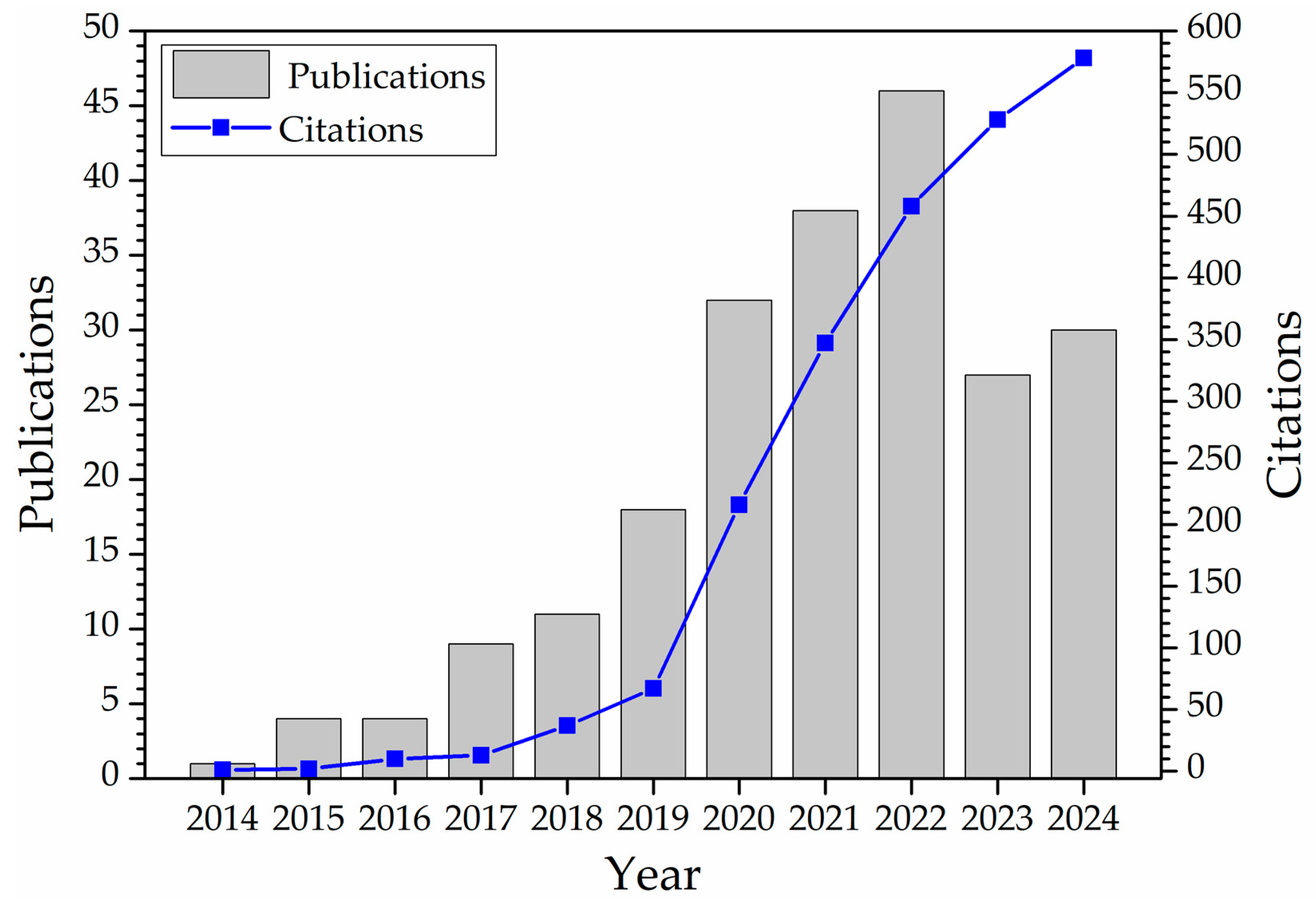
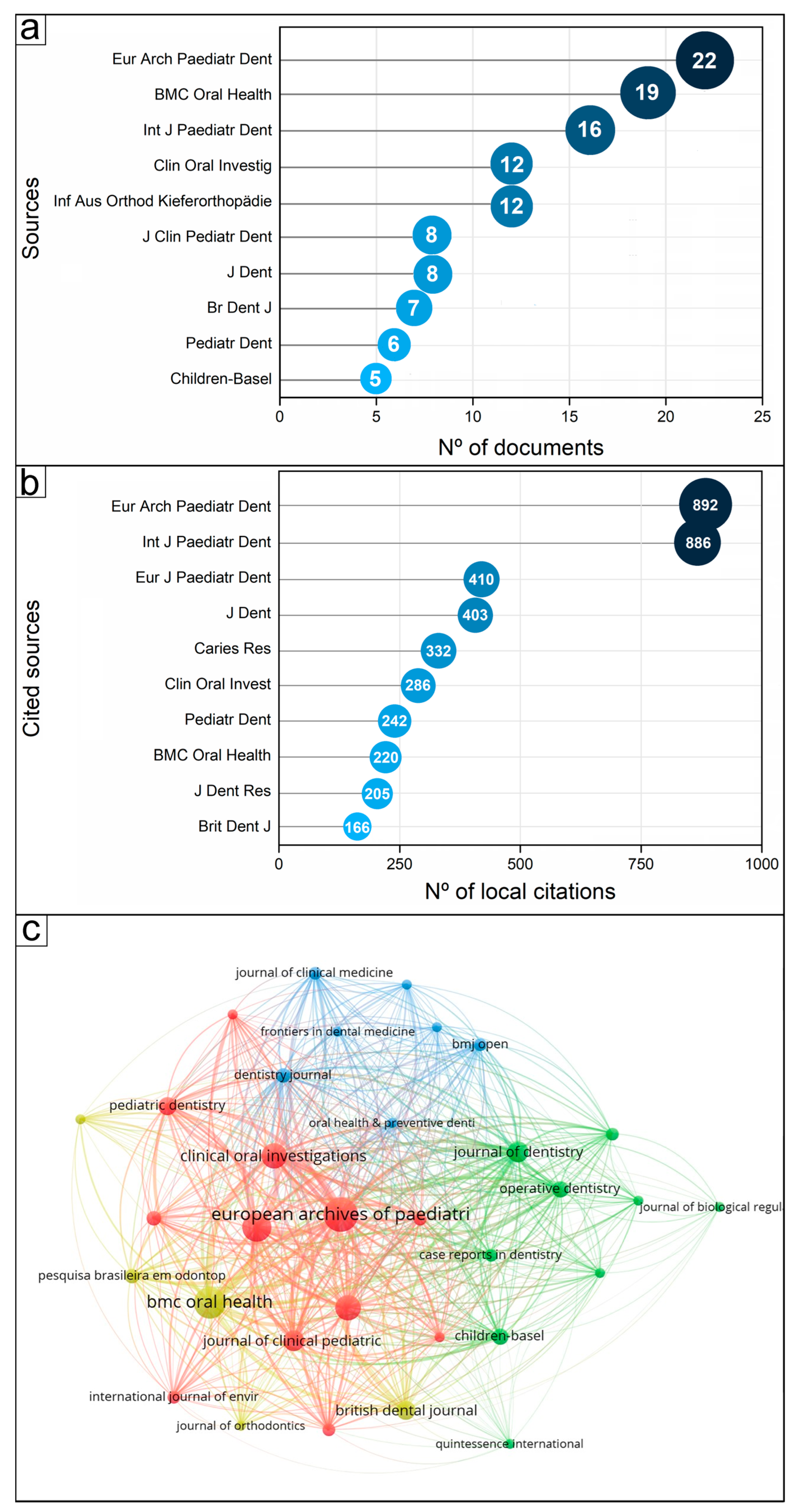
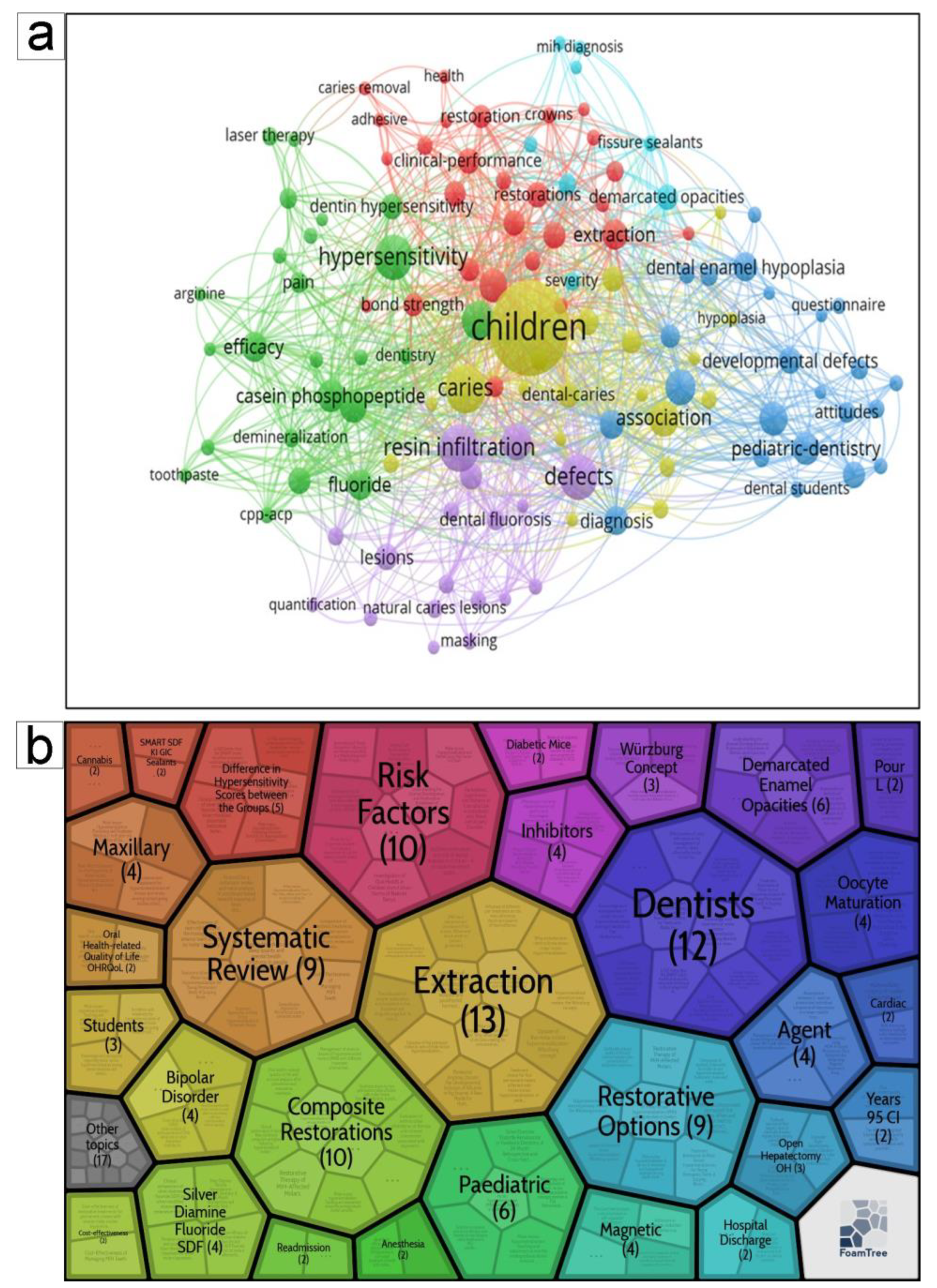
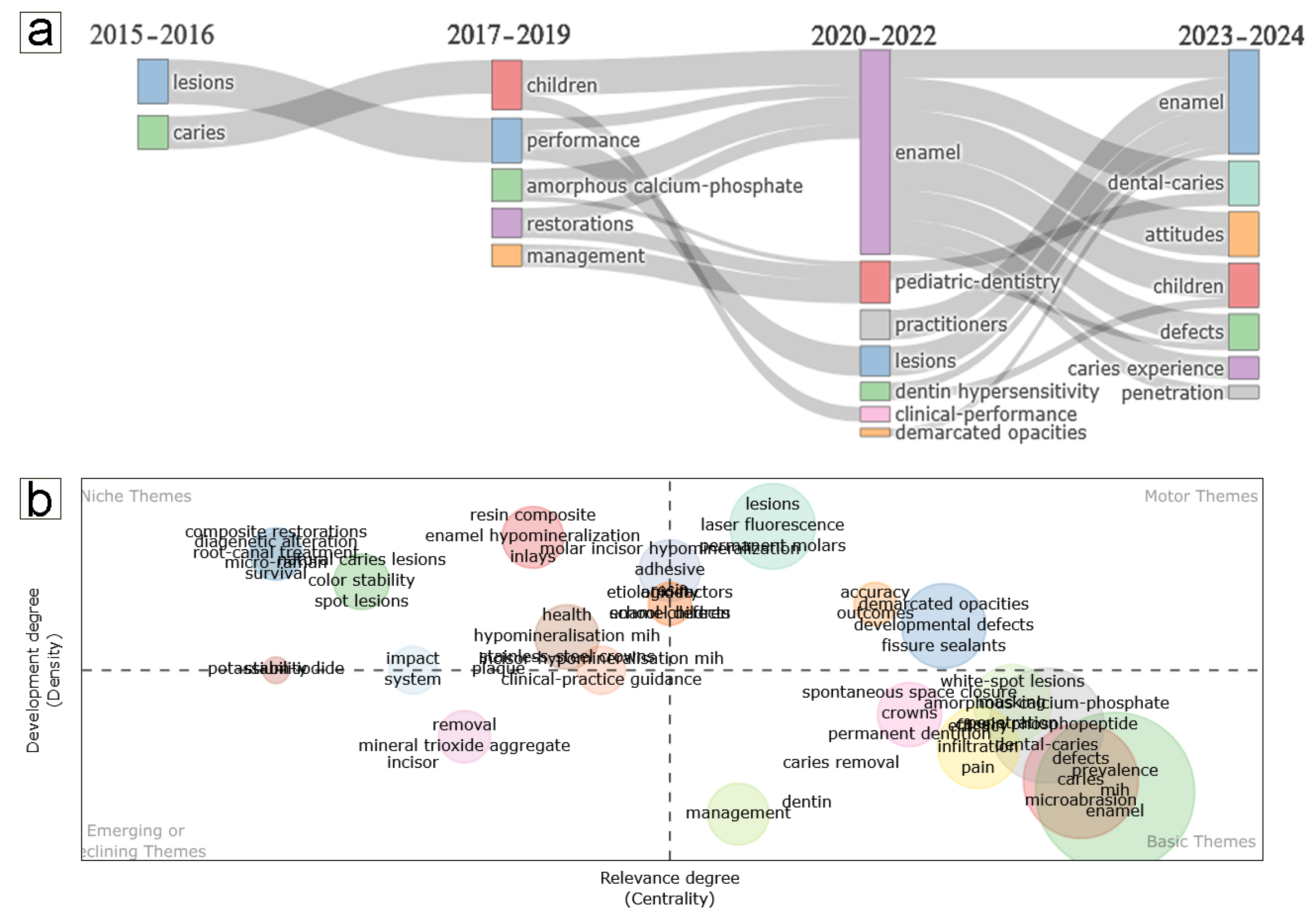

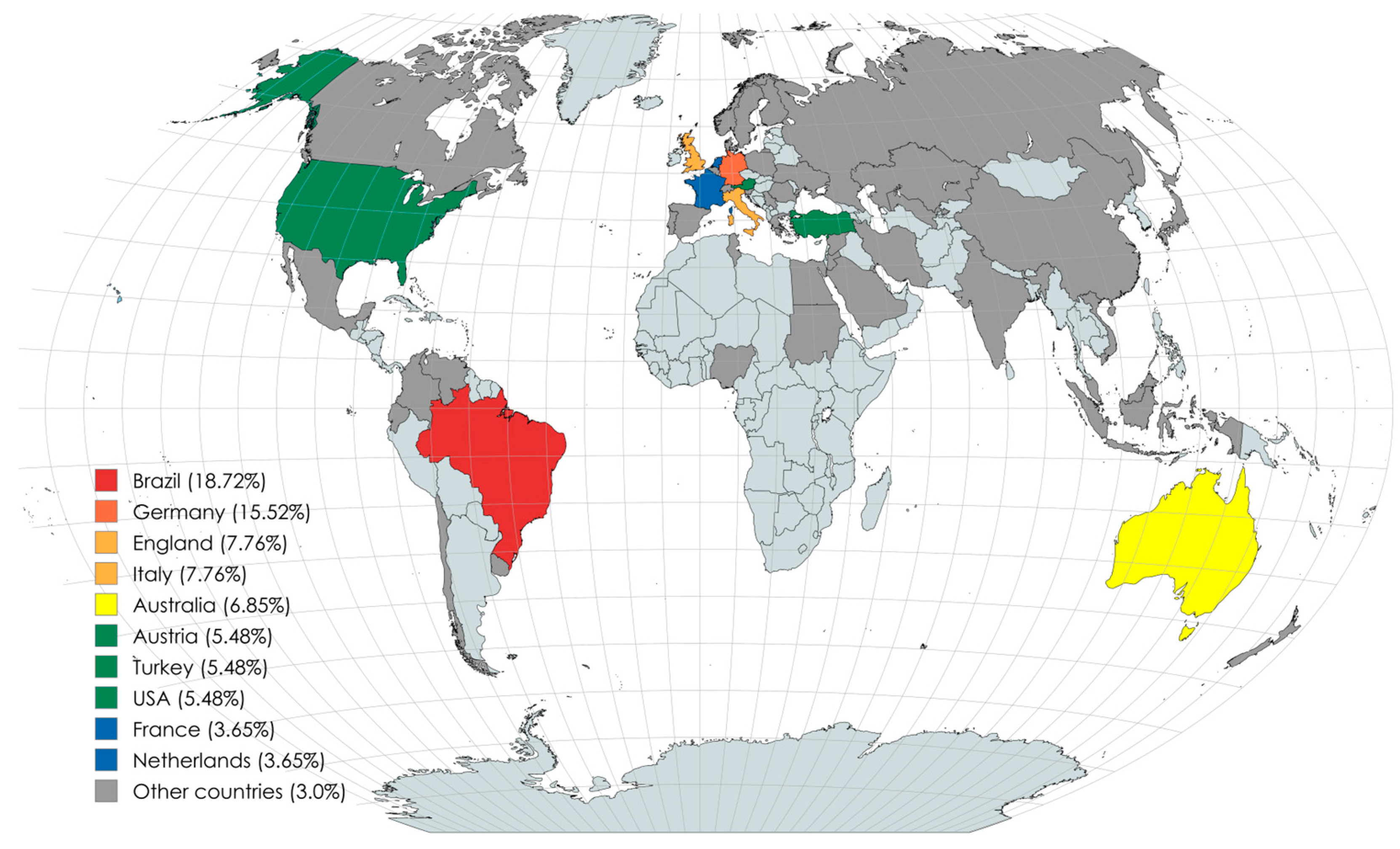

| Database | Search Criteria | Period |
|---|---|---|
| WoS | (All Fields) molar incisor hypomineralization OR (All Fields) molar-incisor hypomineralization OR (All Fields) molar incisor hypomineralisation OR (All Fields) molar-incisor-hypomineralisation OR (All Fields) molar incisor hypomineralisation (MIH) OR (All Fields) MIH AND (All Fields) (treatment *) | 1 January 2014 to 31 December 2024 |
| PubMed | ((((((molar incisor hypomineralization) OR (molar-incisor hypomineralization)) OR (molar incisor hypomineralisation)) OR (molar-incisor-hypomineralisation)) OR (molar incisor hypomineralisation (MIH))) OR (MIH)) AND (treatment or treatments) |
| Rank | Citations | Year | Authors | Title | Journal Impact Fator (Year) | Ref. |
|---|---|---|---|---|---|---|
| 1° | 138 | 2022 | Lygidakis et al. | Best clinical practice guidance for clinicians dealing with children presenting with molar-incisor-hypomineralisation (MIH): an updated European Academy of Paediatric Dentistry policy document | 2.0 (2024) | [14] |
| 2° | 106 | 2016 | Elhennawy et al. | Managing molar-incisor hypomineralization: A systematic review | 5.5 (2025) | [18] |
| 3° | 82 | 2018 | Almuallem et al. | Molar incisor hypomineralisation (MIH)—an overview | 2.3 (2024) | [19] |
| 4° | 81 | 2020 | Seifo et al. | The use of silver diamine fluoride (SDF) in dental practice | 2.3 (2024) | [20] |
| 5° | 58 | 2015 | Fragelli et al. | Molar incisor hypomineralization (MIH): conservative treatment management to restore affected teeth | 1.3 (2025) | [21] |
| 6° | 54 | 2022 | Somani et al. | An update of treatment modalities in children and adolescents with teeth affected by molar incisor hypomineralisation (MIH): a systematic review | 2.0 (2024) | [22] |
| 7° | 50 | 2023 | Butera et al. | Biomimetic hydroxyapatite paste for molar-incisor hypomineralization: A randomized clinical trial | 2.9 (2024) | [23] |
| 8° | 48 | 2017 | Bekes et al. | Efficacy of desensitizing products containing 8% arginine and calcium carbonate for hypersensitivity relief in MIH-affected molars: an 8-week clinical study | 3.1 (2024) | [24] |
| 9° | 44 | 2019 | Coelho et al. | Dental hypomineralization treatment: A systematic review | 4.1 (2024) | [25] |
| 10° | 42 | 2018 | Grossi et al. | Glass hybrid restorations as an alternative for restoring hypomineralized molars in the ART model | 3.1 (2024) | [26] |
| Cluster | Keyword | TLS | Frequency |
|---|---|---|---|
| Children | Caries | 75 | 23 |
| Treatment association | 62 | 14 | |
| Diagnosis | 41 | 10 | |
| Resin infiltration | Tooth defects | 84 | 21 |
| Microabrasion | 66 | 14 | |
| White spot lesions | 43 | 9 | |
| Hypersensitivity | Casein phosphopeptide | 81 | 12 |
| Fluoride | 59 | 11 | |
| Remineralization | 55 | 09 | |
| Management | General dental practitioners | 51 | 13 |
| Diagnosis | 41 | 10 | |
| Dental enamel hypoplasia | 31 | 10 | |
| Performance | Composite resin | 38 | 07 |
| Restorations | 33 | 08 | |
| Extraction | 30 | 11 | |
| Demarcated opacities | Fissure sealants | 24 | 04 |
| Restorative treatment | 15 | 04 | |
| Orthodontic treatment | 07 | 03 |
Disclaimer/Publisher’s Note: The statements, opinions and data contained in all publications are solely those of the individual author(s) and contributor(s) and not of MDPI and/or the editor(s). MDPI and/or the editor(s) disclaim responsibility for any injury to people or property resulting from any ideas, methods, instructions or products referred to in the content. |
© 2025 by the authors. Licensee MDPI, Basel, Switzerland. This article is an open access article distributed under the terms and conditions of the Creative Commons Attribution (CC BY) license (https://creativecommons.org/licenses/by/4.0/).
Share and Cite
Pires, A.A.; Kugelmeier, C.L.; Firoozmand, L.M. Treatment of Molar-Incisor Hypomineralization and Its Impact on Child and Adolescent Oral Health: A Comprehensive Bibliometric Analysis. Appl. Sci. 2025, 15, 9600. https://doi.org/10.3390/app15179600
Pires AA, Kugelmeier CL, Firoozmand LM. Treatment of Molar-Incisor Hypomineralization and Its Impact on Child and Adolescent Oral Health: A Comprehensive Bibliometric Analysis. Applied Sciences. 2025; 15(17):9600. https://doi.org/10.3390/app15179600
Chicago/Turabian StylePires, Abigail Andrade, Cristie Luis Kugelmeier, and Leily Macedo Firoozmand. 2025. "Treatment of Molar-Incisor Hypomineralization and Its Impact on Child and Adolescent Oral Health: A Comprehensive Bibliometric Analysis" Applied Sciences 15, no. 17: 9600. https://doi.org/10.3390/app15179600
APA StylePires, A. A., Kugelmeier, C. L., & Firoozmand, L. M. (2025). Treatment of Molar-Incisor Hypomineralization and Its Impact on Child and Adolescent Oral Health: A Comprehensive Bibliometric Analysis. Applied Sciences, 15(17), 9600. https://doi.org/10.3390/app15179600







